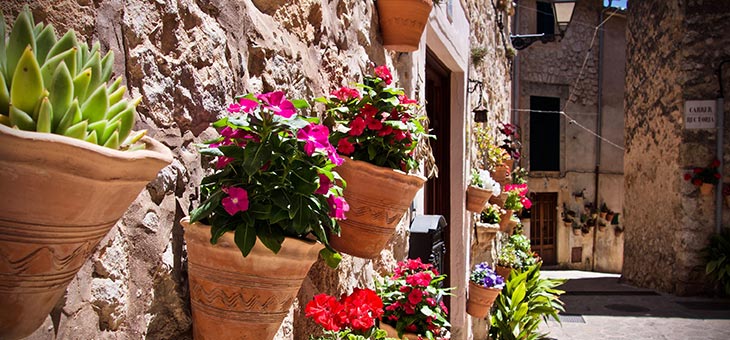In many places in Australia we are lucky enough to be able to enjoy afternoons and evenings in the garden well into autumn. Here’s how you can get that Mediterranean feel if your garden needs a spruce up.

Those with fast-draining or sandy soil may be in an ideal spot to create their own Mediterranean haven, going with gravel, tiles or paving to make a courtyard-style space rather than focusing on a water-guzzling lawn.
1. Use terracotta planters

Think bright pink or red trailing geraniums tumbling over old terracotta or stone pots, or if you’ve limited space attach some smaller terracotta planters to a wall and fill them with trailing drought-lovers that won’t need endless watering.
Read: Australian natives for your garden or balcony
Alternatively, make a feature out of huge Grecian urns strategically placed in borders or as stand-alone features at the end of walkways or in the centre of small courtyards.

Permanent planters in the Mediterranean garden can also save you time, whether it be agapanthus or hardy evergreen herbs. If you situate them on gravel, plunge the base of each container a few centimetres into the gravel, which will encourage plants to root through into the soil underneath as well as keeping your pot stable.

If you have space – and a suitable place to keep them in winter – consider growing a pot of citrus such as lemons, to add a Mediterranean feel and scent.

You can also grow dazzling bougainvillea in containers for a bright pop of colour.
2. Consider gravel or cool tiles

Gravel gardens are commonplace in the Mediterranean, the gravel surface acts as a permanent mulch that will help prevent seed seedlings and conserves moisture.
Choose a sunny, sheltered spot and prepare the soil, raking it level and then spreading 5cm (2in) gravel over the surface.
Plant sparingly – don’t smother the gravel surface with plants. They can be placed here and there and perhaps embellished with stone or terracotta planters or an old wooden or stone bench.

Avoid bedding plants that are too thirsty. Instead, grow exotic-looking shrubs such as phormium and olearia phlogopappa or grasses with silvery leaves, as well as ground cover such as sedum and thyme.
3. Incorporate water

Water creates cool relief in hot countries and can be used not only to provide movement, but also reflective value. Stone fountains are a big feature of many Mediterranean gardens but at home, consider your surroundings.
If you have plenty of room, you might go for an ornate tiered structure, providing a cool cascade of water that you can run your hands through. With less space you might go for still water in a terracotta storage jar or a lined stone trough.
4. Create shade
Any Mediterranean garden worth its salt should offer shade during the heat of the day. Consider how you are going to achieve that naturally. Perhaps grow climbers that love heat, such as grapevine and trumpet vine, over a pergola with traditional seating underneath.
Read: Why gardening is great for mind and body
5. Use drought-tolerant plants

Rock roses (cistus) are a lovely family of shrubs, ideal for a hot sunny position, which will form mounds of green foliage and a profusion of simple flowers, from whites to deep pink.
Other great plants that will thrive in long hot summers include lavender, while for architectural value consider Cupressus sempervirens (Pencil Cypress) one of the archetypal Mediterranean trees, which grows to produce a tall slender green pillar of evergreen interest, perfect for that Med look.

One great option is the Lagerstroemia indica species of crepe myrtle. They are probably the most widely available in Australia and flower in a range of colours – white, red, pink and deep mauve.
Another alternative is the pomegranate tree (Punica granatum), which originated in the region extending from modern-day Iran through Afghanistan and Pakistan to northern India, and has been cultivated since ancient times throughout the Mediterranean region.
This architectural small tree can make a fun alternative to an olive, with larger specimens having very characterful form.

Palms can add that touch of Riviera glamour.
6. Don’t forget succulents

Cacti and succulents are regular features in the Mediterranean garden, growing out of old stone walls and rockwork. If you have a gravel gap between your house and your paving, a strip of sempervivums or other succulents will soften the line beautifully.
Read: How rewilding can boost your garden – and your life
7. Use simple décor

Once you are surrounded by terracotta and old stone or tile landscaping, you don’t really want contemporary, shiny furniture. Choose simple wooden benches or seats that will weather with age, to fit with the look.
And grow herbs such as thyme and oregano near seating areas, which will smell delicious as well as add to the flavour of the food you serve your guests.
Are you looking to renovate your garden? Why not share your gardening tips in the comments section below?
– With PA
If you enjoy our content, don’t keep it to yourself. Share our free eNews with your friends and encourage them to sign up.

